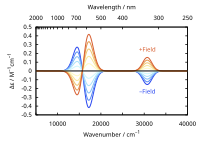Magnetic circular dichroism

Alright kiddo, you know how magnets can stick to metal and they have poles, right? Well, scientists use magnets to study very tiny things called molecules. These molecules are like little building blocks that make up everything around us.
Now, some molecules have a special property called 'chirality'. This means that they can exist as two mirror images that look almost the same, but are actually different. Kind of like your hands - you have a left hand and a right hand that look the same, but they are not exactly the same.
Scientists can use a special technique called 'Magnetic Circular Dichroism' (MCD) to study these chiral molecules. It works like this: they shine light on the molecule and see how much of the light is absorbed. They then twist a magnet near the molecule and shine the light again. This time, they can see if the molecule absorbs more or less light than before, depending on the direction of the magnet's poles.
This helps scientists learn more about how the molecule is structured and how it behaves. It's kind of like a detective looking for clues to solve a mystery!
Now, some molecules have a special property called 'chirality'. This means that they can exist as two mirror images that look almost the same, but are actually different. Kind of like your hands - you have a left hand and a right hand that look the same, but they are not exactly the same.
Scientists can use a special technique called 'Magnetic Circular Dichroism' (MCD) to study these chiral molecules. It works like this: they shine light on the molecule and see how much of the light is absorbed. They then twist a magnet near the molecule and shine the light again. This time, they can see if the molecule absorbs more or less light than before, depending on the direction of the magnet's poles.
This helps scientists learn more about how the molecule is structured and how it behaves. It's kind of like a detective looking for clues to solve a mystery!
Related topics others have asked about:
